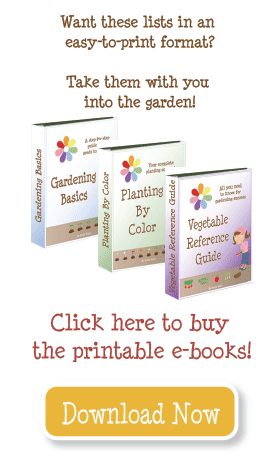| Spring Color | Dates | Spring Color | Dates |
|---|---|---|---|
| White Group | January 18-24 | Yellow Group | March 15-21 |
| Pink Group | February 1-7 | Green Group | March 29-April 4 |
| Red Group | February 15-21 | Blue Group | April 12-18 |
| Orange Group | March 1-7 | Violet Group | April 26-May 2 |
To Do This Week
| Start Seeds Inside | Transplant Plants | Plant Seeds Outside |
|---|---|---|
| Basil* Bell Peppers Cilantro* Dill* Eggplant Oregano* Tomatoes* Thyme* |
Leeks* | Onions (from sets) Peas Turnips* |
| *New plant! This was added since the previous week. | ||
If you haven’t been starting seeds indoors, chances are you haven’t been thinking about gardening yet. Now it’s time! The earliest vegetables can be planted as soon as you can work the soil, which should be happening soon. If you haven’t already done so, create a plan and prepare your garden beds.
Plan
- Decide what veggies you want to plant, and how much of each.
- Create a garden plan! Use the tool linked here, or draw out your garden on paper, mapping out where each type of plant will go.
Prepare
- Complete an inventory and create a list of items you need
for your garden.
- Purchase seeds
, onion sets, compost, and any other equipment you need
.
- Prepare soil by adding compost and/or other amendments, till or turn it.
- Set up trellises
and other supports
for spring vegetables.
Basil
Basil is very easy to grow indoors, even without grow lights.To get a jump start on your basil harvest, start seeds inside now. Just put them in a sunny window. Basil helps repel aphids, so you may want to plant one in each square of lettuce, and between tomato plants.
Bell Peppers
Bell peppers are a tender vegetable that take a long time to grow. In most areas the growing season is too short to plant them as seeds outdoors. Start seeds indoors and transplant it later in the season, or purchase transplants at that time.
Cilantro
Cilantro grows best in cool weather. Some sources say to start it indoors, but others say plant only outside. Either way, once it’s grown it will self-sow with abandon. You may want to dedicate a spot for growing cilantro season after season. Then you can let it go to seed, pull the plants, shake them over the soil, and enjoy the following spring/fall without having to buy or plant seeds.
Dill
Dill requires light to germinate, so don’t plant it too deep in the soil. It’s not always recommended to start dill inside, but this is the only way I’ve been successful in growing dill in the garden.
Eggplant
Eggplant is a tender vegetable that takes a long time to grow. In most areas the growing season is too short to plant them as seeds outdoors. Start seeds indoors and transplant it later in the season, or purchase transplants at that time.
Leeks
Whether you you started from seed or purchased them, leeks can be hardened off and transplanted now.
In raised garden beds leeks require at least 12″ of soil. Before planting, take out the soil until there is 6″ on the bottom and set it aside. Plant leeks 2-3″ deep in the soil, covering the stems up to the leaves. As they grow, gradually replace the soil–keep covering the stem so that only the leaves are exposed. This will blanch the stem, keeping it tender and edible.
Onions
Onions are a hardy vegetable that grow best in cool weather. When planting onions, you have 3 options–seeds, sets, and transplants.
You can start seeds indoors, but I suggest growing them from sets (see below) or transplants, which will be planted in several weeks.
Now is the time to plant onion sets. These look like dry mini-onions. Plant them pointy side up. The smallest sets can be planted every 4-6″ (4 or 9 per square foot) to grow into mature onions. Plant the bigger onion sets every 3″ (16 per square) to grow green onions.
Oregano
Oregano can be started indoors, or planted outside in about 6 weeks.
Peas
Peas are a hardy vegetable that grow best in cool weather. Peas do not transplant well. Plant peas directly in the garden as soon as the ground is no longer frozen and the soil can be worked.
Thyme
Start thyme seeds indoors or purchase transplants later in the season.
Tomatoes
Tomatoes are a tender vegetable that take a long time to grow. In most areas the growing season is too short to plant them as seeds outdoors. Start seeds indoors and transplant it later in the season, or purchase transplants at that time.

